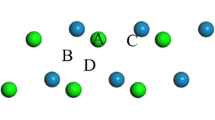Abstract
The adsorption and dissociation mechanism of NH2NO2 on the Mg surface have been investigated by the generalized gradient approximation of density functional theory. Calculations employ a supercell (3 × 3 × 3) slab model and three-dimensional periodic boundary conditions. The strong attractive force between oxygen and Mg atoms induces the N–O bond of the NH2NO2 to decompose. The dissociated oxygen atoms and radical fragment of NH2NO2 oxidize readily Mg atoms. The largest adsorption energy is −860.5 kJ/mol. The largest charge transfer is 3.76 e from surface Mg atoms to fragments of NH2NO2. The energy barriers of N–O bond dissociation are in a range of 11.6–36.5 kJ/mol. The adsorption energy of NH2NO2 on the Mg surface compensates the energy needed for the N–O bond dissociation.





Similar content being viewed by others
References
Goldshleger UI, Amosov SD (2004) Combust Explos Shock 40(3):275
Miller TF, Herr JD (2004) AIAA 2004–4037:2004
Shafirovich EY, Shiryaev AA, Goldshleger UI (1993) J Propul Power 9:197
Dreizin EL, Berman CH, Vicenzi EP (2000) Scripta Mater 122:30
Chen DM, Hsieh WH (1991) J Propul Power 7:250
Koch EC (2005) Propell Explos Pyrot 30:209
Makrlík E, Toman P, Vaňura P (2012) Struct Chem 23:765
Yabe T, Uchida S, Ikuta K, Yoshida K, Baasandash C, Mohamed MS, Sakurai Y, Ogata Y, Tuji M, Mori Y, Satoh Y, Ohkubo T, Murahara M, Ikesue A (2006) Appl Phys Lett 89:261107
Yang YJ, He MG (2010) International Conference on Digital Manufacturing and Automation 1: 780
Brewster MQ, Sheridan TA, Ishihara A (1992) J Propul Power 8:760
Florko IA, Poletaev NI, Florko AV et al (2001) Combus Explos Shock 37:535
Schoenityz M, Dreizin E (2004) J Propul Power 20:1064
Zhou SQ, Zhao FQ, Ju XH, Cheng XC, Yi JH (2010) J Phys Chem C 114:9390
Segall MD, Lindan PJD, Probert MJ, Pickard CJ, Hasnip PJ, Clark SJ, Payne MC (2002) J Phys Cond Mater 14:2717
Perdew JP, Chevary JA, Vosko SH, Jackson KA, Pederson MR, Singh DJ, Fiolhais C (1992) Phys Rev B 46:6671
Perdew JP, Burke K, Ernzerhof M (1996) Phys Rev Lett 77:3865
Kresse G, Furthmüller J (1996) Phys Rev B 54:11169
Fischer TH, Almlof J (1992) J Phys Chem 96:9768
Govind N, Petersen M, Fitzgerald G, King-Smith D, Andzelm J (2003) Comput Mater Sci 28:250
Amonenko VM, Ivanov VY, Tikhinskij GF, Finkel VA (1962) Phys Met Metallogr 14:47
Tyler JK (1963) J Mol Spectrosc 1:39
Partin DE, Williams DJ, O’Keeffe M (1997) J Solid State Chem 132:56
Mulliken RS (1955) J Chem Phys 23:1833
Acknowledgments
The authors gratefully acknowledge the funding provided by the Science and Technology on Combustion and Explosion Laboratory (Grant No. 9140C3501021101) and the Key Laboratory for Attapulgite Science and Applied Technology of Jiangsu Province. S.-Q. Zhou thanks the Research Support of Huaiyin Institute of Technology (Grant No. HGA1008).
Author information
Authors and Affiliations
Corresponding authors
Rights and permissions
About this article
Cite this article
Zhou, SQ., Li, DH., Zhao, FQ. et al. A DFT study of adsorption and decomposition of nitroamine molecule on Mg(001) surface. Struct Chem 25, 409–417 (2014). https://doi.org/10.1007/s11224-013-0298-x
Received:
Accepted:
Published:
Issue Date:
DOI: https://doi.org/10.1007/s11224-013-0298-x




